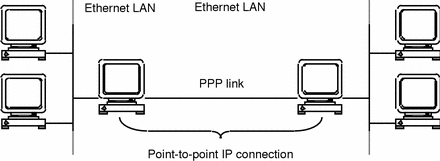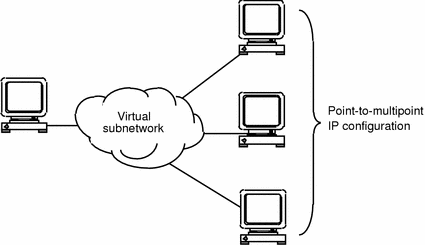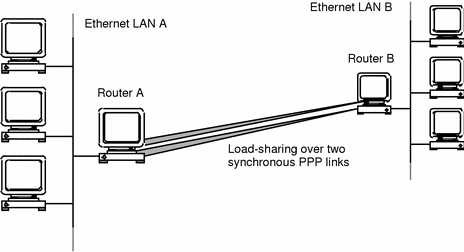Establishing IP over PPP
Once the PPP link is established, the two endpoints negotiate to define a common configuration for the IP layer. During the IP negotiation phase, the two endpoints exchange Network Control Protocol (NCP) frames that contain information about the desired configuration. The negotiated parameters can include the IP address. This feature forms the basis of dynamic IP address allocation.
To route IP datagrams across synchronous or asynchronous PPP links, you must define the logical IP interfaces that represent the boundary between Solstice PPP and the IP layer of the Solaris operating system. These interfaces are initialized with the negotiated configuration information.
Solstice PPP supports two types of IP interface:
Point-to-Point IP Interfaces (ipdptpn)
The point-to-point IP interface for Solstice PPP is /dev/ipdptp. This interface is used to create a direct connection for IP between exactly two hosts, as shown in Figure 1-4.
Figure 1-4 IP Point-to-Point Configuration

A point-to-point IP interface is defined by specifying a source address (or point of attachment) and a unique destination address. There is a single possible destination for the next hop, once the IP datagram has been passed to a given point-to-point interface. Therefore, the same source address can be used for multiple point-to-point connections on the same host. Multiple point-to-point connections can be used to connect to several remote hosts simultaneously.
IP point-to-point connections are supported by both synchronous and asynchronous Solstice PPP links.
Point-to-Multipoint IP Interfaces (ipdn)
The point-to-multipoint IP interface for Solstice PPP is /dev/ipd. A single interface is used to create IP connections between one host and several others, as shown in Figure 1-5. The effect of using point-to-multipoint interfaces is to create a virtual subnetwork, which is usually assigned its own subnetwork number.
Figure 1-5 IP Point-to-Multipoint Configuration

A point-to-multipoint interface is defined by specifying a source address only. There are multiple possible destinations for the next hop, once an IP datagram has been passed to a point-to-multipoint interface. Therefore, each point-to-multipoint interface must be assigned a unique source address.
IP point-to-multipoint connections are only supported by asynchronous Solstice PPP links.
Load-Sharing for Synchronous PPP Links
Load-sharing is a Sun-specific enhancement to the standard implementation of PPP. It increases the available bandwidth by sharing the network traffic from one IP interface equally between two or more synchronous links, as shown in Figure 1-6.
Figure 1-6 Load-Sharing over Synchronous Links

Note -
For optimum performance, all of the synchronous devices used for load-sharing must be operating at the same line speed. Both ends of the link must be running Solstice PPP in order to implement load-sharing.
See "Load-Sharing over Synchronous Links" for a detailed example that shows how to enable load-sharing using Solstice PPP.
- © 2010, Oracle Corporation and/or its affiliates
